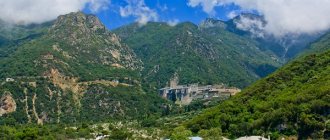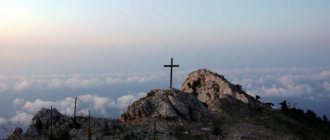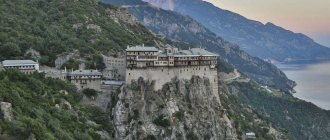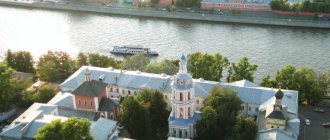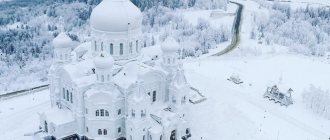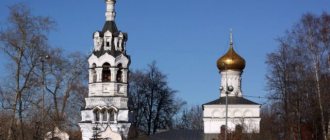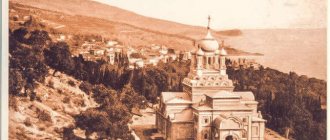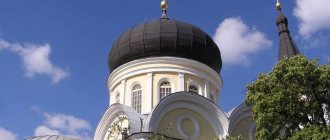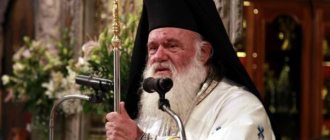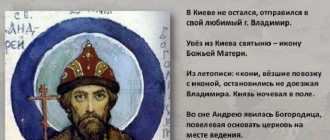The Meteora monasteries are the most striking and unusual attraction of Greece, which can equally be called historical and natural. Meteora is undoubtedly one of the most stunning sights that sightseeing Greece has to offer.
Meteora
- one of the largest monastic complexes in Greece. Their very location is unique - on the tops of rocks. Monks settled here around the 10th century. Since then, the monastery complex has operated continuously, although some of the monasteries have now fallen into disrepair.
Meteora is located in the mountains of Thessaly, in northern Greece, in the Pindus mountain range. They are located near the Pinios River, 1-2 kilometers north of the city of Kalambaka and 21 kilometers northwest of the city of Trikala.
There are currently six Orthodox monasteries operating. The rocks reach a height of 600 meters above sea level and are a rare geological phenomenon. They were formed over 60 million years ago and are the rocky bottom of a prehistoric sea. As a result of the influence of wind, water and temperature changes, massive stone pillars appeared, seemingly suspended in the air, called Meteora (from the Greek μετέωρα - “floating in the air”).
The rocks themselves are difficult to access. And there is absolutely no need to talk about the difficulties of construction in such places - at first glance it seems impossible. The German guidebook for climbers accompanies almost all Meteora routes with the mark “for advanced”, i.e. This means experienced athletes with modern equipment.
All six main monasteries of Meteora are open to the public, but at different times.
Monasteries of Meteora. From the history
Meteors became known to Byzantine hermits long before the 10th century. Seeking solitude, God's people climbed these inaccessible rock peaks, cut off from the world, to be closer to God. They had to live then in caves or in rocky recesses.
The first monastery on Meteora was the oldest monastery of the Holy Spirit, which was built by the hermit Barnabas between 950 and 970. Then the monk Andronikos, who arrived from Crete, built the Transfiguration Monastery in 1020. In 1160, the monastery of Stagi or Dubiani appeared, which marked the beginning of an organized monastic community in these places.
Until the 13th century, peace and tranquility reigned on Meteora, until wars began. The Crusaders, Serbs, Albanians and Turks sought to capture Greek Thessaly.
In 1334, the monk Athanasius arrived in Meteora, expelled from the Holy Mount Athos. He wanted to create in this place a well-organized complex of monasteries in the likeness of those at Athos. He gathered 14 like-minded monks from the surrounding area. They climbed a giant rock 619 meters high. Thus began a truly grandiose event for that era, associated with titanic labor - the construction of the first buildings of the later famous monastery of the Great Meteor or Transfiguration.
The cliff on which this monastery was built was called “Meteor” by Athanasius. According to Athanasius, the cliff seemed to hang between heaven and earth. The result was that the entire mountain complex is now called Meteora.
The 16th century saw the heyday of monastic life in Meteora. The greatness of this place and its natural inaccessibility over time turned it into a large organized monastic community with many monasteries that grew and strengthened.
During the entire existence of this community, 24 monasteries were built on the tops of the rocks. And this is not counting the large number of single cells, ascitiriums, chapels, hermitages, caves, gates, pillars, which were scattered throughout the Meteor mountains.
It was possible to get into the monasteries only by hanging wooden stairs, or in special nets that were climbed by the monks. In the same way, all building materials, food and other things necessary for monastic life were climbed onto the rocks.
In the 20s of the 20th century, roads were built to the monasteries, and stone steps were made in the rocks for the monks and visitors to ascend.
Mount Athos in Greece: location on the map, description, history
The peninsula of Halkidiki is an integral part of Greece, located in the Aegean Sea (northern coast). It has a peculiar appearance and looks like a human hand with 3 fingers. Athos is the “finger” that is located to the right of the others. Stretches 60 km to the southeast.
It is surrounded by the gulfs of Ierisou (on the eastern side), Singitikos (the western part of the peninsula) and the Isthmus of Xerxes. Nearby is Ouranoupolis, a famous city in Greece. People traveling to holy places pass through this place. They want to see Mount Athos, whose height is about 2033 m.
You can only get to the mountain by sea. To do this, you need to take a ship to the main city of the monastic republic of Kareya. Due to strong winds, travelers often take a shortcut and come to Mount Athos from Ouranapolis.
The Athos monasteries in Greece were inhabited by ancient Greek tribes long before the present time. On Mount Athos there were sea routes connecting the country with the East. A thousand years before the birth of Jesus Christ, small towns were located here.
Herodotus and Thucydides in their works highlight the following settlements:
- Dion;
- Physsos;
- Akroafos;
- Olophyxos;
- Apollonia;
- Kleone.
Soon the first monks arrived on Athos. Previously thriving towns of about 10,000 people began to be abandoned.
Transfiguration Monastery (Great Meteor)
The Monastery of the Transfiguration of the Lord , also known as the Great Meteor or Megala Meteora, is the very first monastery built here.
The Transfiguration Monastery was founded around 1340 and is located on the highest and largest rock with a height of 619 meters.
The main cathedral of the monastery - Katholikon - was erected in honor of the Transfiguration of Christ after the death of the founder - monk Athanasius of Meteora, in 1388, in the likeness of the Athos temples. It rises in the center of the entire monastery complex and is a cross-shaped vaulted church with a twelve-sided vault and side niches.
The architecture of the cathedral is the result of a combination of three different stages of construction:
- the ancient temple of St. Athanasius;
- the temple that his successor Joasaph built;
- temple, built in 1545 by the abbot of Epirus Simeon.
Decoration of the main cathedral
The eastern wall of the temple contains Byzantine masonry and vaults with two domes, arches and sloping roofs. The external features of the temple are the masonry of the walls with square stones surrounded by bricks in a row. These thin bricks also surround the arches above the windows, ending in crenellations and ceramic-plastic decorations.
On the marble slab of the window there is an inscription about the restoration of the temple, made by Abbot Joasaph in 1388.
The only complete scene of the Second Coming, belonging to the period of the first decoration of the Cathedral during the time of St. Athanasius, has been preserved on the north wall.
To the left of the entrance is an inscription about the construction of the temple in 1544-1545 under the leadership of Abbot Simeon.
The picturesque decoration of the Cathedral was also carried out in three stages, but with long breaks in time. In the first stage, the painting of the temple was created (around 1388). The only scene that has survived from those times is the Second Coming on the outside of the north wall of the old cathedral. The basis of the composition is Christ Pantocrator under the arches, surrounded by two angels. To the left and right under the arch are the Mother of God and John the Baptist, begging Christ for the salvation of mankind. In the center are the figures of the apostles sitting on a rectangular bench. The two lower belts of the composition depict Heaven and Hell with the righteous and sinners, respectively.
After the restoration of the Church of the Transfiguration in 1545, the new temple and nave were decorated with new frescoes in 1552. Significant areas that emerged at the end of 1545 allowed rich icon painting to flourish.
Buildings on the territory of the monastery
There are also 2 smaller chapels on the territory of the monastery:
- Chapel of John the Baptist
- completed to the south sanctuary and connected to it. The chapel is small and has a dome. It has not been restored since the 18th century. In fact, the original building dates back much earlier. - The Chapel of St. Constantine and St. Helena
is located a few meters from the Cathedral and is located in the southwest. The premises are also small in size, built according to the post-Byzantine simple royal type with a dome. There is no wall iconography. The dome rests on four imitation arches and is polygonal from the outside.
>Varlaam Monastery
The Monastery of St. Varlaam or All Saints is one of the oldest monasteries in Meteora. It stands on the site of a hermitage monastery founded by Saint Barlaam. He is also a famous figure who played a key role in the history of Meteora shortly after Athanasius arrived there.
The current building was founded by two brothers Apsaras from Ioannina in 1540-1544, it is considered one of the most beautiful in the valley. The Catholicon of the monastery, dedicated to All Saints, is small but brilliant: it is supported by painted beams, and the walls and pillars are completely covered with frescoes.
In the refectory there is a museum with an exhibition of icons, fabrics, decorated furniture and other church and household utensils. You can also see in another place the barrel in which the monks kept drinking water.
A lifting tower has been preserved in the monastery of St. Varlaam. This is not a safe design, consisting of a receiving platform and a now unused mechanism with a winch (later replaced by an electric winch). Although now, as in the old days, ropes and a “basket” are in use.
In the 1920s, steps were cut here. As was written above, steps were made in all monasteries. The initiator of this was the Bishop of Trikala, who clearly cared about his reputation, which, undoubtedly, could have suffered if something had happened to some careless foreigner.
So ropes and baskets are now used only for delivering supplies and building materials to the top, especially since there are also trailers of a cable car thrown over the abysses, which begins in the nearby car park.
Monastery of the Holy Trinity in Meteora
The Holy Trinity Monastery is built on a cliff 400 meters high. Reliable historical information about the founder of the monastery has not been preserved. The first written mention of the monasteries of the Holy Trinity and Megala Meteora is dated 1362, i.e. They apparently appeared at about the same time.
The cathedral on the territory of the Holy Trinity Monastery was built in 1476, as clearly indicated by the inscription on one of the facades of the temple.
The two-column cross-shaped vaulted Cathedral of the Holy Trinity Monastery was built in the Byzantine style and decorated with wall frescoes. The decoration of the nave was carried out at the very end of the 17th century, and the decoration of the main temple - in 1741.
To the right of the altar is the sacristy. The treasures that were once located here, for the most part, along with the monastery bells, were plundered during the time of foreign conquests.
The surviving ancient icons and manuscripts of the Holy Trinity Monastery have now been transported to the Varlaam Monastery and the St. Stephen Monastery, where they are kept.
As you ascend, at the entrance to the monastery there is a small church of St. John the Baptist carved into the rock, built and painted in 1682 by the monk Nicodemus.
In addition to the temples, the Holy Trinity Monastery has monks' cells, a kitchen, a refectory, two rainwater tanks and a small plot of cultivated land.
Behind the cathedral of the Holy Trinity Monastery there is a balcony from which there is a picturesque panorama of the city of Kalambaka, neighboring monasteries, as well as two rocks on which monasteries once operated, which have not survived to this day.
Monastery of Rusanu or St. Barbara
The time of creation of the Rusanu
or
Arsani
and the origin of its name are not known for certain. According to one version, the founder of the monastery was a certain Rusanos, a native of the town of Rosana. According to other unconfirmed sources, the monastery was founded in 1288 by hieromonks Nicodemus and Benidikt.
It is known for sure that in 1545, with the permission of the Metropolitan of Larisa Vissarion and the abbot of the Great Meteor Monastery, immigrants from Epirus - the brothers hieromonks Joasaph and Maxim - built the monastery catholicon. It appeared on the site of the destroyed Church of the Transfiguration and is made in the Byzantine style. The brothers also restored the monastery, which operated as a dormitory.
The monastery was repeatedly plundered. The relics of the monastery, which have survived to this day, are again now moved to the Transfiguration Monastery (Great Meteor). During the Turkish persecutions of 1797 and the Greco-Turkish War of 1897, residents of the surrounding villages took refuge within the walls of the monastery.
By 1940, the monastery fell into decay and lost its inhabitants. Since 1950, Elder Eusevia from the neighboring village of Kastraki single-handedly maintained the three-story structure of the monastery. After the death of the elder in 1971, the monastery was closed due to poor technical condition. But soon, in the 1980s, the monastery buildings were restored by the Greek Archaeological Service. Currently, there is a convent here, which received its second name in honor of St. Barbara.
The monastery's Catholicon - the Church of the Transfiguration with an atypical altar facing north, is a two-pillar cross-domed structure with a vestibule. The church was painted in 1560 by unknown icon painters of the Cretan school. These paintings were not recorded in subsequent centuries and have been preserved in good original condition. Also of great value is the wooden carving with gilding of the iconostasis.
Monastery of St. Stephen
Meteora MonasteriesMeteora MonasteriesThe last and easternmost monastery of St. Stephen is about a 15-minute walk from the Holy Trinity Monastery. You just need to walk along the road and around the bend suddenly the abode you need appears. This monastery is also active and is now for women: nuns sell all sorts of trinkets.
The monastery suffered greatly from bombing in World War II and communist raids during the civil war. This monastery is the first on the list of attractions that you can skip if you don’t have enough time.
It is, of course, impossible not to say that in the 15th century refectory there is a fresco painting of the Virgin Mary on the apse, and in the museum, a little further away, there is an excellent “Epitafios” - a tombstone embroidered with gold. The old trail from St. Stephen's Monastery to Kalambaka is unused and unsafe.
Features of monastic governance on Mount Athos
The system of government of Athos is based on 7 Charters, which were approved from the date of the creation of monasticism until the beginning of the 19th century. The Charter of 1924 is of paramount importance in its development.
Synaxis, that is, the Sacred Assembly, heads the legislation of the country. It consists of 20 priests of the monasteries, who meet from time to time in Kareya for the purpose of discussing and adopting firmly established decrees. When urgent issues arise, a “double meeting” takes place, which includes 40 people.
Sacred Kinot is the head of administrative power. There are 20 people under his care (from each of the monasteries). They are elected on the 1st day of January. The reign period is 1 year.
The executive branch is led by the Sacred Epistasy. It includes 4 representatives. The chairman of the Sacred Epistasy is a member of the monastery with 1st rank. It is called prot (first) or protepistate.
Prot can be chosen by 5 monasteries:
- Dionisiev.
- Iversky.
- Great Lavra.
- Hilandarsky.
- Vatoped.
The monasteries send an additional member to Karea to fill the position of prote. The other 3 candidates are chosen from among the members of the Sacred Kinot. Elections of representatives of Epistasia are scheduled for the 1st day of June, who immediately begin to perform their functions.
Judicial power is vested entirely in institutions located both within and outside the mountain.
The location of the governor is Karey. He depends on the Ministry of Foreign Affairs and monitors the correct implementation of the main points of the Charter. Subordinate to the governor are police stations, government apparatus and officials - members of the Athos state in Greece.
Monastery of St. Nicholas Anapavsas
The Monastery of St. Nicholas Anapavsas , in comparison with the other five monasteries that have survived to this day, is located on a relatively low cliff.
The exact time of foundation of this monastery is unknown, but the first ascetic monks appeared here in the 12th - 13th centuries.
The first written mention of the monastery on this rock dates back to 1392, and architectural data and remains of wall frescoes confirm the version of construction in the 13th or 14th century.
The monastery was rebuilt. The buildings that have survived to this day arose in the last years of the 15th century on the ruins of an older monastery. Its founder is considered to be the monk Nikanor Anapavsas, after whom the monastery is named.
The narrow and limited surface of the rock on which the monastery is located has a small area, so all the buildings were built high on several levels, one above the other.
On the first level there is a chapel dedicated to St. Anthony, with a small altar with an area of only 4 square meters.
On the second level there is the catholicon of the monastery - the Cathedral of St. Nicholas. It was built in 1527 over the entire area of the rock. The cathedral was built in the shape of a rectangle without windows. It consists of a quadrangular nave and a cruciform main church, and is crowned with a low dome.
The iconographic decoration of the cathedral was carried out by the outstanding Orthodox artist of the Cretan school Theophanes Strelitzas Bafa, known as Theophanes of Crete, who, despite the difficulties due to lack of space in the temple, was able to realize his entire rich iconographic program.
On the third level of the monastery of St. Nicholas Anapavsas there are cells, an old refectory, a small church of St. John the Baptist and a crypt where the relics and skulls of the monks are kept.
At the entrance to the monastery, in a rock gorge, there is a small church of St. Simeon.
At the beginning of the 20th century, the monastery of St. Nicholas was empty, its buildings gradually began to fall into disrepair, and the valuable manuscripts stored there were transferred to the monastery of the Holy Trinity. In the 1960s, the monastery was restored and is still in operation today.
Why are women not allowed to visit Mount Athos?
There are 2 versions according to which women are prohibited from coming to Athos:
| Version name | Description |
| Official | The charter of the 10th century states that female creatures (we are talking about animals) have no right to appear on the Holy Mountain. Nothing is said about girls here. But everyone already knew that women were prohibited from entering the men’s temple. This rule was introduced to ensure that monks do not violate their vow of celibacy. |
| Orthodox | This version claims that the Virgin Mary got lost on her way to Cyprus. In an attempt to find her destination, she settled on Mount Athos. The mountain captured her heart. The Virgin Mary, with the consent of her son, considered this territory to be her property. To this day it is called the “Garden of the Mother of God.” According to legend, the Mother of God is the only woman who has been to the mountain. |
There are many cats on Mount Athos for catching mice.
This is the only reason why the monks turn a blind eye to the fact that many of them are females. Some girls were still able to visit the Athos monasteries in Greece, bypassing the taboo. The Holy Mountain provided shelter for peasants during the Greek Civil War. Among them were not only men, but also women with daughters.
The Greek authorities officially banned women from visiting the peninsula after the incident with Maria Poimenidou in 1953. To get to Athos, she disguised herself as a man. Now those who violate this ban will be punished with imprisonment for a period of 1 year.
Athonite monks are friendly and welcoming. However, you should not ask them questions that do not relate to life in the monastery. This territory does not tolerate haste and rudeness. Travelers who arrive in the sacred land of Greece receive peace and grace in return.
Author: Ekaterina Pisarenko
Article design: Vladimir the Great
Uninhabited and ruined monasteries of Meteora
Not all Meteora monasteries have survived to this day. There are currently six operating ones, but there are also non-residential ones in Meteora.
Among them are:
- Monastery of St. George of the XIV century,
- Monastery of St. Nicholas Batov, founded in 1400,
- Monastery of the Presentation of Christ, built in 1367,
- Monastery of the Holy Apostles of the 16th century,
- Monasteries of John the Baptist and St. Modest of the 17th century,
- Monasteries of St. Gregory and St. Anthony of the 14th century and many others.
Currently, these Meteora monasteries are in a ruined state, but people know about their existence, history and prosperity both from handwritten scrolls and from the remains of ruins that are visible in various parts of the stone massif.
Time to visit the Meteora monasteries
The Meteora monasteries are open to visit by believers and tourists on set days and times. Admission for Greek citizens is free, for others - 3 euros.
Monastery visiting hours:
| Name of the monastery | Winter (1/11-31/03) | Summer (1/04-31/10) | Closed |
| Transfiguration Monastery (Great Meteor) | 9:00-16:00 | 9:00 — 17:00 | Tuesday (winter and summer), Wednesday (winter) |
| Varlaam Monastery | 9:00-16:00 | 9:00-16:00 | Thursday (winter), Friday (winter and summer) |
| Monastery of the Holy Trinity | 10:00-16:00 | 9:00-17:00 | Wednesday (winter), Thursday (winter and summer) |
| Monastery of Rusanu or St. Barbara | 9:00-14:00 | 9:00-16:00 | Wednesday |
| Monastery of St. Stephen | 9:30-13:00 and 15:00-17:00 | 9:00-13:00 and 15:00-17:00 | Monday (winter and summer) |
| Monastery of St. Nicholas Anapavsas | 9:00-14:00 | 9:00-15:30 | Friday (winter and summer) |
Where to stay near the Meteor monasteries
It will probably take a whole day to see the monasteries of Meteora. So it’s better to plan a stop for the night right there, nearby. To do this, you need to consider the town of Kalambaka or, preferably, the village of Kastraki, which is 2 kilometers to the northeast. In Kastraki the atmosphere is better, and the rocks are very close. You can also enjoy walking along the stone pavements of the ancient upper part of the village. Living conditions in Kastraki are suitable for those who do not want to waste money without receiving the appropriate quality in return. The village also has two campsites, which are among the best in the area.
Kalambaka town
Kalambaka cannot boast of any special attractiveness, except for its proximity to the rocks. The town has several squares, each with a fountain. Kalambaka burned during World War II (the Germans did their best). As a result, only a few pre-war buildings survived. In particular, the ancient Metropolitan Cathedral has been preserved. It is located a couple of blocks up the hill from the new current cathedral, at the very top of the village.
But there is a railway station, located on the southern edge of the village. There are buses to Kalambaka that stop at the central plateau of Dimarchiu. But the bus station is actually a little lower, downhill, opposite the railway station. There is no information desk for tourists in Kalambaka. So look for information and maps in the bookstore on the west side of the same square. It is located on the corner of Ioanninon and Patriarch Dimitriou. For those arriving on buses and trains, barkers are usually waiting for you, as at all train stations in the world, promising a good overnight stay. It’s not a fact that taking advantage of their offers is the best solution.
There are many hotels along the main street. But don't expect much from them. There are a lot of tourists in them, and double glazing in the rooms does not protect from street noise. A good option for a tight wallet is the inexpensive but hospitable Meteora Hotel on Plutarch 13.
In the upper and more village-like part of the town, about 700 meters from both main squares, near the Metropolis and the starting point of the path to the Holy Trinity Monastery, there are two more standing shelters.
Kastraki village
You can walk to Kastraki from Kalambaka in 20 minutes, but you will have to walk along a busy and not very safe highway.
During the season (May 15-September 15), buses run regularly between Kalambaka and Kastraki all day long. Arriving at the village from its lower edge, you will proceed past the first of two campsites here. This is Camping Vrachos, where during the season the local outfitter also offers sports adventures in the surrounding area to visitors. The second campsite, Camping Boufidhis-The Cave (May-October), operates on the upper edge of the road that runs through the entire village. It is a little more cluttered, but there is so much wonderful grass there (if the year is not dry), and the tents are in the shade. Not to mention the luxurious location: on the far edge of the village and therefore closer to the cliffs. Here the monasteries of St. Nicholas Anapavsas and Rusanou literally soar in height.
There are many rooms for rent in the village. The level is sometimes quite high. There are also five hotels. It is important to choose a place away from the main highway towards the monasteries - buses rattle along the highway every now and then all day long.
1 1 vote
Vote for the article!
How did you get there?
In all resort areas, tourists are offered to buy an excursion to Meteora. If you wish, you can visit the monasteries on your own; from Athens there is a direct train to Kalambaka (300 km); from Thessaloniki you will have to change trains in Paleofarsalos (200 km).
We traveled by car. A detailed route for our travel around mainland Greece is published in the article “Ready route around Greece: 10 days of traveling by car.”
We left for Kalambaka on November 3 from the island of Corfu. We were transported to the mainland by a 13-hour ferry. There was no queue, the ferry was almost empty, it took 1 hour and 40 minutes. I wrote detailed information about the ferry crossing in the article “Ferry to Corfu: cost and schedule.”
Just outside the port of Igoumenitsa, the highway to Thessaloniki begins. The road is new, the road surface is of excellent quality, it winds, there are no steep serpentines. There were a lot of tunnels, we had to slow down to 70 km/h.
We were in no hurry, the weather was excellent (+24), we enjoyed the magnificent scenery. After about 115 km we went into the mountains, followed the navigator (offline maps Sygic), there are signs to Meteora.
After the highway, a serpentine road immediately begins, steep in places, with sections of descent alternating with sections of ascent. Refueling in 10 minutes. They topped up the diesel and paid by card.
The mountain road offers stunning views, we often stopped and took photographs. As we walked, it became cooler, so we had to take out our jackets.
There are villages along the way, but everything is closed and deserted. The traffic is not intense, there are small trucks, we didn’t see any buses at all.
Kalambaka appeared somehow immediately. The town is small and cozy, the mountains rise beautifully right above the houses. On the right there is a station and a dead end, there is no further railway. After another couple of kilometers there is a large hypermarket on the right.
Dusk fell imperceptibly. I didn’t want to wander around in the dark, so we didn’t linger and went straight to the hotel.
